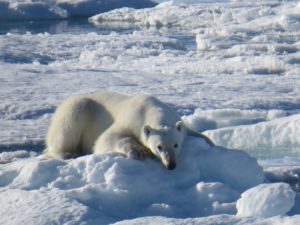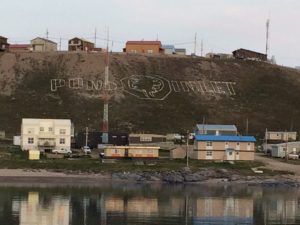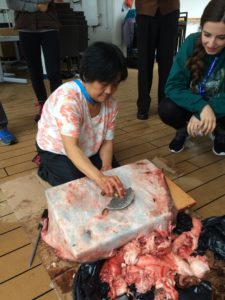Aug. 15, 2017
Our second day on Canada C3 was a day of thinking through what reconciliation means for me.ô As one of the themes of this journey, weãre practicing reconciliation by learning about the ways of knowing of the Inuit, as well as the those of First Nationsã peoples across Canada.ô The morning found us in Tay Bay for our first hike on the land, guided by Jaypooti Aliqatuqtuq, an Inuit hunter, guide, and bear guard who is on this leg with us.ô His deep knowledge of the land was apparent in his explanation of bear tracks, owl pellets, native plants, and hunting sites ã he is attuned to details in nature that most of us missed. ô Another one of the respected members of our journey is Charlene Bearhead, a knowledge-keeper from Edmonton.ô A mother of 6 & grandmother to 7, Charlene has been the Education Lead on the National Truth & Reconciliation Commission, and is now the Education Coordinator of the National Inquiry into Murdered and Missing Indigenous Women and Girls.ô She is also a co-chair of the Gord Downie & Chanie Wenjack Fund, which supported the Legacy Room on the ship.ô This contemplative space is filled with gifts from First Nation and Inuit communities along the Canada C3 route ã lacrosse sticks, an Inuit drum, handmade snowshoes, books, and many meaningful artworks. ô Charlene gave us a wonderful introduction to the Room and to the Fund (if you’re not familiar with it, please look it up.)
We were honouredô to witness Jaypooti give Charlene a gift of polar bear claws for this room, which came from one of his hunts ã it was an emotional moment that touched us all.ô And the day ended with our first spectacular polar bear sighting on an ice flow, as well as observing broad-winged murres and kittiwakes on the steep cliffs Cape Hay.ô Paul Smith, a bird biologist on the trip, shared his knowledge of how these remarkable birds survive in this harsh climate. This led me to think of the knowledge, the relationships, and the resilience we can learn from the Inuit, from First Nationsã peoples, and from ãmore-than-humanã beings like polar bears and seabirds, if only we take the time to listen, to observe, to feel and to connect. ô For me, part of reconciliation is learning to see and respect the deep connections between all life forms on this planet, and how we can play active roles in contributing to their – and ultimately our own – health and longetivity.



 ô ô
ô ô 

